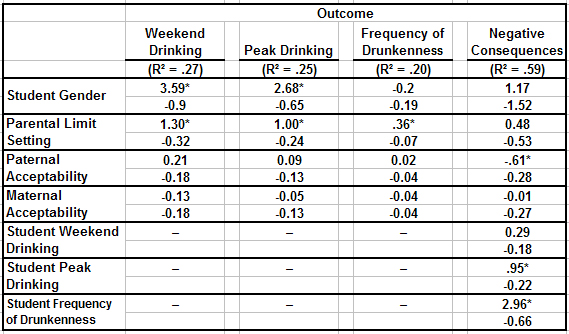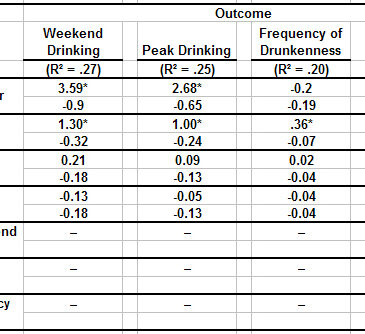Research indicates that alcohol abuse is linked to negative consequences (e.g., drunk driving, physical altercations, etc.) among college students (Hingson, Heeren, Winter, & Wechsler, 2005). Although previous research has shown that parental influence diminishes when adolescents enter college, more recent research suggests that parents still have some influence (Galotti & Mark, 1994; Lehr, Dilorio, Dudley, & Lipana, 2000). This week the DRAM reviews a study that examined the impact of parental permissibility of alcohol use during late high school on alcohol use and negative drinking consequences experienced among college students (Abar, Abar, & Turrisi, 2009).
Methods:
- The researchers randomly recruited 500 freshmen college students from a northeastern university to complete an online survey assessing their parent-teen communication and alcohol use behaviors.
- Participants (N=290, 58% response rate) were at least 18 years of age, were 61% female and 88.9% Caucasian; 97.2% lived in dormitories.
- The survey consisted of demographics and questions designed to measure:
- parent permissibility of alcohol (i.e., student report of parent limit setting in high school and maternal and paternal acceptance of alcohol);
- student drinking behavior (i.e., weekend drinking, peak drinking, and frequency of being drunk in the past month); and
- negative consequences of alcohol within the last year (26 items from the Young Adult Alcohol Problem Screening Test; Hurlbut & Sher, 1992).
Results:

Figure. Parent permissibility and students’ drinking behavior and negative consequences – unstandardized B weights and SEs (adapted from Abar et al., 2009). Click image to enlarge.
*p < .001. Note. These weights reflect a saturated structural equation model that also included other family variables, none of which contributed significantly. For student gender, 1=male and 0=female. For parental limit setting, a high score indicates permissive limits. Click image to enlarge.
- Students reported consuming an average of 9.14 drinks per weekend (SD=7.98), an average peak of 7.04 drinks (SD=5.77) on one occasion, being drunk an average of 1.86 (SD=1.65) times, and experiencing an average 18.90 (SD=16.44) negative consequences from alcohol in the past month.
- Parent permissibility was predictive of college drinking behaviors (see Figure).
- Permissive parental limits for alcohol use in high school were associated with greater college drinking but not negative consequences.
- Higher paternal acceptability of alcohol use in high school was associated with fewer negative consequences of college drinking.
- Separate analyses found that students whose parents had allowed no drinking during high school reported less college drinking (M diff weekend drinks = -4.99, t (254) = -5.14, p<.001; M diff peak drinks = -3.56, t (256) = -5.10, p<.001; M diff frequency of drunkenness = -1.08, t (256) = -5.51, p<.001) and experienced fewer negative consequences (M diff= -10.10, t (256) = -5.03, p<.001) than their college peers.
Limitations:
- The study used self-report and retrospective data.
- Parental variables reflected student perceptions of parent behavior.
Conclusion:
This study does not support the theory that allowing adolescents to experiment with drinking will lead to a later reduction in alcohol misuse. Instead, the study indicates that having parents who allowed any drinking during high school was a significant risk factor for alcohol misuse during college. The size of those limits, if greater than zero, did not affect negative consequences, and paternal acceptance of alcohol use had a negative effect on consequences, suggesting that among students whose parents allowed some drinking in high school, the relationship between parent permissiveness and alcohol misuse is more complicated.
— Tasha Chandler
What do you think? Please use the comment link below to provide feedback on this article.
References:
Abar, C., Abar, B., & Turrisi, R. (2009). The impact of parental modeling and permissibility on alcohol use and experienced negative drinking consequences in college. Addictive Behaviors, 34(6-7), 542-547.
Galotti, K. M., & Mark, M. C. (1994). How do high school students structure an important life decision? A short term longitudinal study of the college decision-making process. Research in Higher Education, 35, 589-607.
Hingson, R., Heeren, T., Winter, M., & Wechsler, H. (2005). Magnitude of alcohol-related mortality and morbidity among U.S. college students ages 18-24: Changes from 1998 to 2001. Annual Review of Public Health, 26, 259-279.
Hurlbut, S. C., & Sher, K. J. (1992). Assessing alcohol problems in college students. Journal of American College Health, 41(2), 49-58.
Lehr, S. T., Dilorio, C., Dudley, W. N., & Lipana, J. (2000). The relationship between parent-adolescent communication and safer sex behaviors in college students. Journal of Family Nursing, 6, 180-196.





Larry Frank July 8, 2009
Very interesting subject matter, somewhat confusing article. For us non-researchers, charts focusing on standard deviation and “saturated structural equation models” is far beyond my practical understanding. And the results section seems contradictory: “As Table 1 shows……..Higher paternal acceptability of alcohol use in high school was associated with fewer negative consequences”. Fewer, really? Later, “….students whose parents had allowed no drinking during high school reported ……. experienced fewer negative consequences (M diff= -10.10, t (256) = -5.03, p<.001) than their college peers. Fewer again? What am I missing. Maybe, I will try to track down the original source.
BASIS Staff July 15, 2009
Dear Larry,
Thank you for commenting on The DRAM 5(6) – High School Limits and College Drinking: Parental Influence on College Students’ Alcohol Use, which reviewed the study authored by Abar, Abar, and Turrisi (2009).
Your comment about the complexity of the statistical analysis is appropriate. In our reviews, we are limited to the information the authors provide in the original article. This article allowed us to present only the coefficients from multi-variate regression models. However, your comment provoked us to make the table of results more clear by defining the direction of the relations in the table note. For example, for limit setting, there are positive coefficients, indicating that, where significant, more permissive limits relate to more drinking. For paternal acceptability, there is a negative coefficient, indicating that greater acceptability by the father is associated with fewer negative consequences.
You also noted that the results seemed contradictory: increased paternal acceptability of alcohol and not allowing drinking in high school were both associated with fewer negative consequences of college drinking. The results of the Abar et al. study were mixed and that is one reason we chose to review the study in the BASIS. We noted that “the relationship between parent permissiveness and alcohol misuse is …complicated.
Again, thank you for your interest in the BASIS and for your comment. We always appreciate reader feedback, questions, and comments.
–The BASIS Staff
Abar, C., Abar, B., & Turrisi, R. (2009). The impact of parental modeling and permissibility on alcohol use and experienced negative drinking consequences in college. Addictive Behaviors, 34(6-7), 542-547.